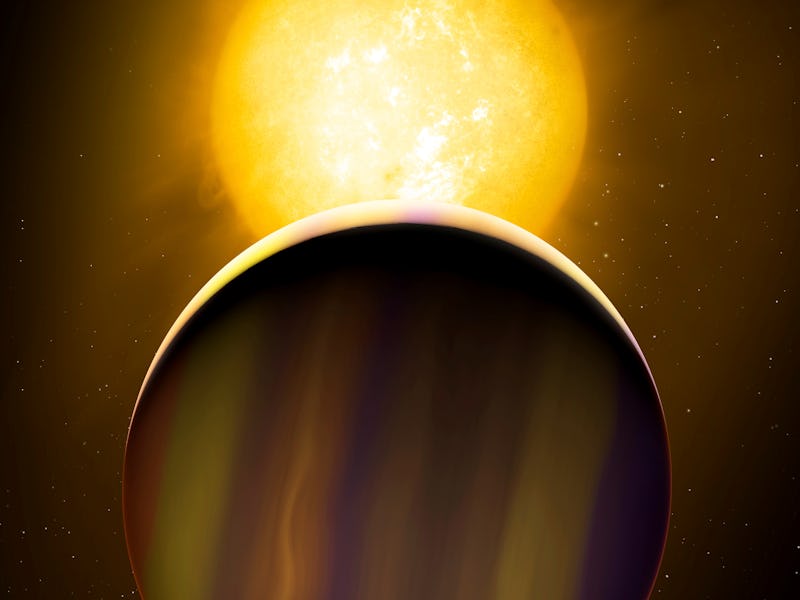Gaseous and scorching “hot Jupiters” make tilted loops around their parent stars
Scorching ''hot Jupiters" sometimes orbit their parent stars along wonky orbits.

A fiery type of alien world called a “hot Jupiter” can enter a tilted orbit relative to its parent star, and a new study could help puzzled researchers get to the bottom of why.
In March, NASA announced the 5,000th known exoplanet — with the first around a Sun-like star discovered in 1995. But that planet was like nothing we’d seen before. The first discovered planet around a main-sequence star, 51 Pegasi b, speeds around its parent star in just four days, with an orbit less than five percent the distance between the Sun and Earth. But astronomers have never been quite sure how these hot Jupiters form.
NASA explains exoplanets.
But the new study, accepted for publication in The Astrophysical Journal, looks at possible scenarios for how they form and why the Solar System isn’t like this.
Why it matters — Our Solar System provides a good benchmark for the sorts of planets that may exist far beyond the Sun’s influence in deep space. Astronomers use those near Earth, like Venus, to shape how they interpret data about these distant worlds known as exoplanets.
In fact, scientists also use Solar System names to describe exoplanets that don’t have exact proxies in our cosmic neighborhood. You’ll see astronomers throw around terms like “super-Earths” and “mini-Neptunes,” and in this case, hot Jupiters.
Exoplanet infographic by NASA.
One peculiar difference between our home and those far away star systems is that Earth and its siblings orbit along the same plane and on par with the Sun’s equator. The Solar System is a flat disk, with all the planetary orbits essentially operating as concentric circles. But that’s not always the case.
“While we have found that some hot Jupiters are aligned just like the Solar System, we’ve also seen that many hot Jupiters are misaligned from the rotation of their host stars,” Jacob Hamer, a Johns Hopkins University astrophysicist, said on Monday while presenting the new work at the 240th Meeting of the American Astronomical Society (AAS).
These puzzling tilts, called obliquities, could be a big clue about how hot Jupiters form.
A rendering of exoplanet HIP 67522 b, a hot Jupiter discovered in June 2020.
Digging into the details — Before they began collecting a sample of hot Jupiter observations, Hamer’s team thought it possible for all hot Jupiters to form in wonky orbits. Then by interacting with their stellar parent, they eventually orbit aligned, or flat when compared to the star’s rotation.
If this is true, aligned systems should be older than misaligned ones, since the disorderly hot Jupiters would need time to get into the aligned groove.
“It was very difficult to answer this question,” Hamer says, “because measuring the age of an individual star very precisely is one of the hardest problems in astrophysics.”
What’s new — Enter Gaia, the eight-year-old satellite mapping the motions of 1 billion stars in the Milky Way.
Hamer’s team was surprised by what they found. After determining relative ages for several hot Jupiter systems thanks to Gaia’s Data Release 2 (DR2) and Early Data Release 3 (EDR3) observations, they noticed that the misaligned orbits were older than the aligned orbits, throwing a wrench in the idea that hot Jupiters with tilted orbits eventually mellowed out into the plane of their parent star.
“We think that there’s only one explanation for this observation,” Hamer said. “Misaligned hot Jupiters arrive on their orbits late, and aligned hot Jupiters arrive on their orbits early.”
A diagram for misaligned versus aligned orbits of hot Jupiters.
What they discovered — Stars and planets are made of the material swirling around inside a protoplanetary disk. In these beginning stages, hot Jupiters form and then migrate towards the system's center to be next to their parent star.
Jupiter, Saturn, Uranus, and Neptune are outer planets because they probably formed farther away from the Sun than did rocky worlds like Earth. The same likely happens in many distant systems. A gaseous exoplanet will form far from its star, and becomes a hot Jupiter by migrating inward.
This trip could be what causes the obliquities.
If a hot Jupiter snuggles up to its parent star after the disk disappears, a hot Jupiter can make a cosmic bee-line towards their final, tight orbit. But suppose a hot Jupiter begins that inward journey while there is still a disk. In that case, the planet will interact with other objects — perhaps another exoplanet or a companion star — and arrive later into its eccentric orbit.
Sometimes, a misaligned hot Jupiter may correct itself and become aligned.
What’s next — “What this tells us is that there’s not a single way that hot Jupiters form,” Hamer said. “They actually have multiple formation processes.”
There’s still plenty to explore. Astronomers may expand the science of hot Jupiters and reveal more about the oddities of planetary formation when the sensitive instruments on missions like NASA’s James Webb Space Telescope begin detecting even more alien worlds.
This article was originally published on